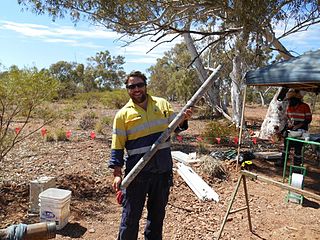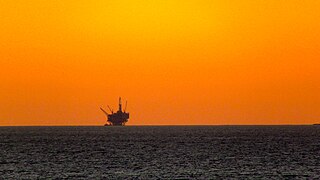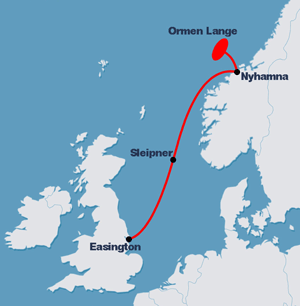
Geotechnical engineering, also known as geotechnics, is the branch of civil engineering concerned with the engineering behavior of earth materials. It uses the principles of soil mechanics and rock mechanics to solve its engineering problems. It also relies on knowledge of geology, hydrology, geophysics, and other related sciences.

An oil platform is a large structure with facilities to extract and process petroleum and natural gas that lie in rock formations beneath the seabed. Many oil platforms will also have facilities to accommodate the workers, although it is also common to have a separate accommodation platform bridge linked to the production platform. Most commonly, oil platforms engage in activities on the continental shelf, though they can also be used in lakes, inshore waters, and inland seas. Depending on the circumstances, the platform may be fixed to the ocean floor, consist of an artificial island, or float. In some arrangements the main facility may have storage facilities for the processed oil. Remote subsea wells may also be connected to a platform by flow lines and by umbilical connections. These sub-sea facilities may include one or more subsea wells or manifold centres for multiple wells.

Offshore construction is the installation of structures and facilities in a marine environment, usually for the production and transmission of electricity, oil, gas and other resources. It is also called maritime engineering.

In engineering, a foundation is the element of a structure which connects it to the ground or more rarely, water, transferring loads from the structure to the ground. Foundations are generally considered either shallow or deep. Foundation engineering is the application of soil mechanics and rock mechanics in the design of foundation elements of structures.

Engineering geology is the application of geology to engineering study for the purpose of assuring that the geological factors regarding the location, design, construction, operation and maintenance of engineering works are recognized and accounted for. Engineering geologists provide geological and geotechnical recommendations, analysis, and design associated with human development and various types of structures. The realm of the engineering geologist is essentially in the area of earth-structure interactions, or investigation of how the earth or earth processes impact human made structures and human activities.

Seabed gouging by ice is a process that occurs when floating ice features drift into shallower areas and their keel comes into contact with the seabed. As they keep drifting, they produce long, narrow furrows most often called gouges, or scours. This phenomenon is common in offshore environments where ice is known to exist. Although it also occurs in rivers and lakes, it appears to be better documented from oceans and sea expanses.

Geotechnical investigations are performed by geotechnical engineers or engineering geologists to obtain information on the physical properties of soil earthworks and foundations for proposed structures and for repair of distress to earthworks and structures caused by subsurface conditions; this type of investigation is called a site investigation. Geotechnical investigations are also used to measure the thermal resistance of soils or backfill materials required for underground transmission lines, oil and gas pipelines, radioactive waste disposal, and solar thermal storage facilities. A geotechnical investigation will include surface exploration and subsurface exploration of a site. Sometimes, geophysical methods are used to obtain data about sites. Subsurface exploration usually involves soil sampling and laboratory tests of the soil samples retrieved.

A deep foundation is a type of foundation that transfers building loads to the earth farther down from the surface than a shallow foundation does to a subsurface layer or a range of depths. A pile or piling is a vertical structural element of a deep foundation, driven or drilled deep into the ground at the building site.
Marine architecture is the design of architectural and engineering structures which support coastal design, near-shore and off-shore or deep-water planning for many projects such as shipyards, ship transport, coastal management or other marine and/or hydroscape activities. These structures include harbors, lighthouses, marinas, oil platforms, offshore drillings, accommodation platforms and offshore wind farms, floating engineering structures and building architectures or civil seascape developments. Floating structures in deep water may use suction caisson for anchoring.

Offshore drilling is a mechanical process where a wellbore is drilled below the seabed. It is typically carried out in order to explore for and subsequently extract petroleum that lies in rock formations beneath the seabed. Most commonly, the term is used to describe drilling activities on the continental shelf, though the term can also be applied to drilling in lakes, inshore waters and inland seas.
Subsea technology involves fully submerged ocean equipment, operations, or applications, especially when some distance offshore, in deep ocean waters, or on the seabed. The term subsea is frequently used in connection with oceanography, marine or ocean engineering, ocean exploration, remotely operated vehicle (ROVs) autonomous underwater vehicles (AUVs), submarine communications or power cables, seafloor mineral mining, oil and gas, and offshore wind power.
"Offshore", when used in relation to hydrocarbons, refers to operations undertaken at, or under the, sea in association with an oil, natural gas or condensate field that is under the seabed, or to activities carried out in relation to such a field. Offshore is part of the upstream sector of the oil and gas industry.

A fixed platform is a type of offshore platform used for the extraction of petroleum or gas. These platforms are built on concrete and/or steel legs anchored directly onto the seabed, supporting a deck with space for drilling rigs, production facilities and crew quarters. Such platforms are, by virtue of their immobility, designed for very long-term use. Various types of structure are used, steel jacket, concrete caisson, floating steel and even floating concrete. Steel jackets are vertical sections made of tubular steel members, and are usually piled into the seabed. Concrete caisson structures, pioneered by the Condeep concept, often have in-built oil storage in tanks below the sea surface and these tanks were often used as a flotation capability, allowing them to be built close to shore and then floated to their final position where they are sunk to the seabed. Fixed platforms are economically feasible for installation in water depths up to about 500 feet ; for deeper depths a floating production system, or a subsea pipeline to land or to shallower water depths for processing, would usually be considered.

Suction caissons are a form of fixed platform anchor in the form of an open bottomed tube embedded in the sediment and sealed at the top while in use so that lifting forces generate a pressure differential that holds the caisson down. They have a number of advantages over conventional offshore foundations, mainly being quicker to install than deep foundation piles and being easier to remove during decommissioning. Suction caissons are now used extensively worldwide for anchoring large offshore installations, like oil platforms, offshore drillings and accommodation platforms to the seafloor at great depths. In recent years, suction caissons have also seen usage for offshore wind turbines in shallower waters.

A submarine pipeline is a pipeline that is laid on the seabed or below it inside a trench. In some cases, the pipeline is mostly on-land but in places it crosses water expanses, such as small seas, straits and rivers. Submarine pipelines are used primarily to carry oil or gas, but transportation of water is also important. A distinction is sometimes made between a flowline and a pipeline. The former is an intrafield pipeline, in the sense that it is used to connect subsea wellheads, manifolds and the platform within a particular development field. The latter, sometimes referred to as an export pipeline, is used to bring the resource to shore. Sizeable pipeline construction projects need to take into account many factors, such as the offshore ecology, geohazards and environmental loading – they are often undertaken by multidisciplinary, international teams.

Subsea production systems are typical wells located on the seabed, shallow or deep water. Generally termed as Floating production system, where the petroleum is extracted at the seabed and the same can be tied back to an already existing production platform or an onshore facility. The oil platform well is drilled by a movable rig and the extracted oil or natural gas is transported by submarine pipeline under the sea and then to rise to a processing facility. It is classified into

A strudel is a vertical hole in sea ice through which downward jet-like, buoyancy-driven drainage of flood water is thought to occur. This feature is less than a few tens of meters in size and typically occurs within 30 km from a river mouth, in the sea ice expanse that is fastened to the coastline. Once the water that flooded the ice has completely drained off the ice surface, strudel become recognizable by a radial pattern of feeder channels that lead to the hole. They are elongated and irregularly spaced, with the larger ones up to several kilometers apart. Their distribution tends to be controlled by weak areas in the ice – in places, they line up along fractures or refrozen extensional cracks. The ice sheet where they occur may be 2 m in thickness, at water depths in the order of a few meters.

Offshore embedded anchors are anchors intended for offshore use that derive their holding capacity from the frictional, or bearing, resistance of the surrounding soil, as opposed to gravity anchors, which derive their holding capacity largely from their weight. As offshore developments move into deeper waters, gravity-based structures become less economical due to the large size needed and the consequent cost of transportation.
Susan Gourvenec is a British geoscientist who is Professor of Offshore Geotechnical Engineering and deputy director of the Southampton Marine and Maritime Institute at the University of Southampton. She was elected a Fellow of the Royal Academy of Engineering in 2022.
Marine construction is the process of building structures in or adjacent to large bodies of water, usually the sea. These structures can be built for a variety of purposes, including transportation, energy production, and recreation. Marine construction can involve the use of a variety of building materials, predominantly steel and concrete. Some examples of marine structures include ships, offshore platforms, moorings, pipelines, cables, wharves, bridges, tunnels, breakwaters and docks. Marine construction may require diving work, but professional diving is expensive and dangerous, and may involve relatively high risk, and the types of tools and equipment that can both function underwater and be safely used by divers are limited. Remotely operated underwater vehicles (ROVs) and other types of submersible equipment are a lower risk alternative, but they are also expensive and limited in applications, so when reasonably practicable, most underwater construction involves either removing the water from the building site by dewatering behind a cofferdam or inside a caisson, or prefabrication of structural units off-site with mainly assembly and installation done on-site.

























